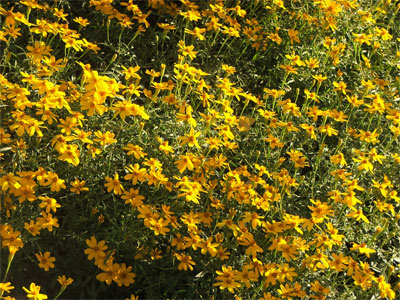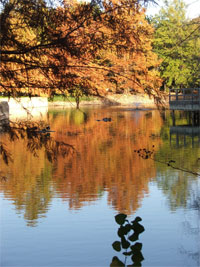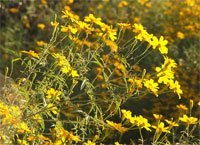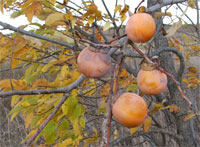Native Son – November, 2008

Copper Canyon daisies (Tagetes lemmonii).
All photos by Steven Chamblee.
Copper Canyon Daisies and Eastern Persimmon

Reflections at Clark Gardens.
Jeweled leaves are flying from the trees, and the Jardin de Chandor glows with rich, ruddy hues of gold, red and purple. The breeze carries upon it both the coolness of change and the soft dampness that tells me the time of winter rest is approaching. The flowerbeds have burst their seams, and blossoms spill out onto the paths that were carefully sewn across this garden so many years ago. Full of this spirit, this gratefulness that consumes me every autumn, I glide down little serpentine country roads that quickly bring me to the gates of the Jardin de Clark.*
The rich tapestry of tones continues here, as if the two places were cut from the same cloth … but here, the rich rust color of the bald cypress trees echoes and reverberates across the garden and paints the mirrored waters. I emerge from quiet shade of the trees into the warm sun, and before me waves a large mass of Copper Canyon daisy. It is literally boiling with butterflies, as the golden-yellow blossoms, heavy with sweet nectar, swing back and forth in the breeze.

Copper Canyon daisies (Tagetes lemmonii).
Copper Canyon daisy (Tagetes lemmonii) is kin to the annual marigolds so popular in our gardens. Here in North Texas, this plant is a herbaceous perennial, which means it dies down to the crown every winter and emerges fresh every spring. The foliage is finely divided, giving the plant a delicate appearance. But don’t let that fool you … this baby is one of the most heat- and drought-tolerant plants around. And those tiny leaves are packed with aromatic oils that are easily released with just a touch. Some people find this scent strong and pungent; others find it spicy and refreshing. (Personally, I love it, but then again, I like most plant fragrances and find almost everything at the high-dollar perfume counter rather noisome.) While most people find its natural open growth habit quite lovely, you can easily shear Copper Canyon daisy to form if you like, but don’t trim after July or you will lose the fall flower fiesta. This lovely fall-bloomer is quite at home in butterfly and resource-wise gardens from Denton south to … well, Mexico.
Oh yes, that name….
Copper Canyon daisy is a native of Mexico, home of that mind-altering, 89-tunnelled, more-twists-than-a-plateful-of-spaghetti train ride through the Barranca del Cobre (Copper Canyon).
And speaking of trains … you have visited the miniature train exhibit over at Clark Gardens, right? A true “must see” for the kids, these little trains glide out of the station into a special miniature garden built just for them. (It’s also a lot of fun to watch grown men turn into little boys again, right in front of your eyes.) For more info, visit www.clarkgardens.com or call 940-682-4856.

The ride home finds me wading hip-deep through a splendid meadow to visit a special friend I call Eastern persimmon. (When she gets in trouble, her parents shout out “Diospyros virginiana! Come here right now!”) As you might guess from her formal name, she’s an East Coast girl who rambled west and south all the way to the Edwards Plateau in Texas. She’s tall (up to 40 feet) and has a hard heartwood — so hard that folks have made billiard balls and golf club heads from it. Spring and summer, she dresses up in glossy green leaves that dangle at a peculiar angle, which helps me find her among others in the woodlands. Some years she dresses up regally in fall colors of bright yellow, red, purple, and, believe it or not … pink, but this year she has just kind of let herself go and settled for dull yellow and brown. Tossing aside her leaves, she exposes her nice, plump, two-inch wide fruits for all to see. Shameless hussy…. I caress the succulent fruit, and, oh yes, it yields slightly to pressure. Hmmmm … I wonder. She offers freely, so I succumb to her temptation and take a bite.
Yeeeeowwweeeeeee! My cheeks suck inward, my lips retreat under my front teeth, and my eyes water like busted pipes. My body curls over into a standing fetal position and I almost fall over because even my toes are curled. Memories flood my brain of similar past experiences … me and my 10-year-old buddies gagging and laughing … adult me telling a tour group, ”they’re never really ripe until mid-January”… my father grinning broadly at guests and announcing, “Stevie’s as sweet as a green persimmon.”
The tongue-tang torture continues for four or five minutes as I wipe the tears from my eyes and try to get the remnant fruit bits out of my mouth, which is hard to do when your tongue feels like a worn wooden spoon and your cheeks have the consistency of dried sponge. I look skyward for assistance from the Great Beyond, only to see Zeus laughing and Jove taunting, “Diospyros, silly fool … ‘Fruit of the Gods.’”
Finally recovering, I snap a few photos of this arboreal provocateur and turn to head back to the truck. A single fruit falls to the ground right in front of me. Hmmm … that’s right, they don’t fall off unless they’re ripe. As I bend over to pick it up, I hear a faint little snicker upon the wind. My hand stops short, and I decide to leave it for the opossums. Not this time, ol’ Zeus, not this time. I look back at my friend, Eastern, and she does her best Betty Boop, smiling innocently and saying, “What did I do?”
I arranged for a date on January 15 and drove out of sight.
* Clark Gardens Botanical Park is located between Weatherford and Mineral Wells, along the Lake Mineral Wells State Park Trailway.
About the author: Steven Chamblee is the chief horticulturist for Chandor Gardens in Weatherford and a regular contributor to Neil Sperry’s GARDENS magazine and e-gardens newsletter. He adds this invitation to e-gardens readers:
Come see Chandor Gardens all dressed up for the holidays! We’re having a special Open House Celebration on Sunday, Dec. 14, from 1 p.m. to 5 p.m. Admission is complimentary, and we’ll have musicians and refreshments and such … all free! You can always call 817-613-1700 or go to www.chandorgardens.com for a picture tour and more information.
Please remember …
Wintertime is garden renovation time at Chandor Gardens, so we’ve suspended our formal weekend schedule until early spring. We will do our best to accommodate you during this time, but please call first to let us know you’re coming. The main line is 817-613-1700, and my office line is 817-598-4029.
